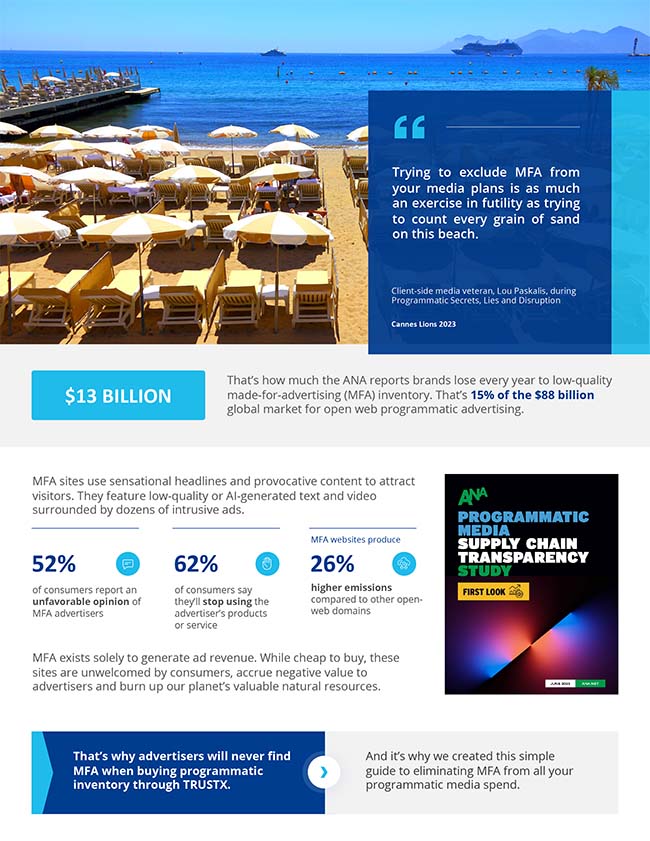2023 will go on record as the year when even the most intractable climate change deniers must be wondering if their hardline beliefs might actually be wrong. Reputable news outlets like Reuters reported that this summer’s temperatures “surpassed previous records by a large margin.” Furthermore, regulators are implementing mandatory climate reporting requirements for publicly-traded companies, 40% of which admit being unprepared to measure and report on their carbon emissions.
With words like “climate” and “carbon” now part of the vernacular across a wide spectrum of industries, those of us in digital advertising have a unique opportunity to pull a few levers that, without a lot of effort and complexity, can drive a materially positive result when it comes to saving our planet. The two easiest that stand out are: (1) to cease spending on made-for-advertising (MFA) websites, and (2) when buying through programmatic markets, to do so only through direct supply paths.
The easiest carbon lever of them all: Get rid of MFA
Scope3 predicts that digital ads will produce a jaw-dropping 7.2 million metric tons of emissions in 2023, equivalent to a year’s worth of electricity for 1.4 million US households.
Much of this carbon is generated by MFA websites, which produce 26% more emissions than reputable domains. Low-quality clickbait has been around since the dawn of the internet, but today, the landscape is filled with high-carbon sites full of pop-ups, intrusive ads, cookies and autoplay videos, all of which contribute to a high computational load.
These carbon facts make the results of ANA’s recent Programmatic Media Supply Chain Transparency Study especially worrisome. ANA reported that 15% of the media spend they evaluated went to MFAs. When extrapolated across the $88 billion global market for open web programmatic advertising, that represents a whopping $13 billion in wasted media value and millions of tons of carbon emissions.
The uncomfortable truth is that we’re pouring a fortune into websites that present poor user experiences, increase brand suitability risks, and deliver subpar results, all while increasing emissions. As an industry, we’re not just falling short of our sustainability goals, we’re paying dearly for the privilege.
The polar opposite of MFA is premium publishing. As a group, premium content delivers tangible economic value to advertisers without any of MFA’s energy-intensive complexities. Whereas MFA sites deliver notoriously lackluster results, particularly with engagement metrics like CTR and video completion, the superior performance of premium media is well-documented:
- Premium publishers are 3x more effective in driving mid-funnel brand lift metrics such as favorability, consideration and intent to recommend.
- Consumers are 39% more likely to engage with an ad in a high-quality content environment than with ads on low-quality sites.
According to Ebiquity, reallocating investment from MFA to high-quality journalism, for example, can boost ad effectiveness and lower emissions by 52%, reinforcing the strong case for brands to allocate the entirety of their open-web media budgets to premium inventory.
The next lever to improve your programmatic sustainability equation: Buy only through direct supply paths
There’s no escaping the fact that programmatic markets create more emissions than good old-fashioned direct deals. Carbon purists might opt to eliminate all programmatic advertising from their budgets, but the automation delivers undisputed commercial benefits for advertisers and publishers, which makes such an option unattractive.
But there are ways to reduce the net effect of programmatic on our environment, the most straightforward of which is to straighten the path between programmatic media buyers and sellers. Direct supply-paths burn far less than circuitous routes between the same parties.
Like with MFA, advertisers buying programmatic media through indirect supply-paths are paying for the privilege of missing their sustainability goals. According to Jounce Media, the average publisher engaging in RTB works with 24 directly integrated supply platforms. Of these partners, 11.4 are authorized to initiate resold auctions and each extra indirect hop adds cost in real-dollar terms and in carbon emissions. Jounce estimates that these reseller supply chains account for 35% of display auctions and 36% of video auctions, generating exponential amounts of emissions for unwitting buyers.
Three easy and achievable steps to materially reduce our collective carbon footprint
It’s easier than you’d think to eliminate spend with MFA sites, boost campaign metrics that matter and expedite our collective path towards materially reducing digital advertising’s carbon footprint.
- Establish an inclusion list of premium primary sellers and buy only from your list. In the world of programmatic advertising, a primary seller is the corporate entity that has the direct authorization to monetize a publisher’s inventory. Primary sellers manage programmatic sales for one or more domains or apps. For example, DotDash Meredith is the primary seller for a few dozen domains and apps like InStyle and AllRecipes. Raptive (fka Café Media) is the primary seller for thousands of domains like MacRumors, Natasha’s Kitchen and Gardener’s Path. A thoughtfully curated inclusion list of 50 to 100 brand-suitable, premium sellers will provide buyers with enormous scale across a wide diversity of content, all without the dangers (and waste) from MFA.
- Insist on 100% direct supply-paths. The adtech supply-chain lives and breathes on resold inventory, creating circuitous multi-hop supply-paths between media buyers and sellers. The practice increases adtech revenue at the expense of energy that negatively impacts every campaign’s carbon footprint.
100% direct-sold supply paths give advertisers more working media value for the money, while also using far less energy thanks to the streamlined process. Given the way programmatic works today, the most sustainable path to premium inventory looks like this: Quality DSPs are capable of restricting spend to direct supply-paths, and for these companies, there are economic incentives to do so. Advertisers and agencies simply need to make it a non-negotiable requirement.
Quality DSPs are capable of restricting spend to direct supply-paths, and for these companies, there are economic incentives to do so. Advertisers and agencies simply need to make it a non-negotiable requirement. - Validate that you bought the inventory you planned to buy. The old adage, “don’t expect what you don’t inspect” applies. Log-level data is the most granular way to verify that your DSP and SSPs delivered your ads where you anticipated and through the direct supply paths you demanded. That said, most programmatic tech partners can deliver the data to validate your plan through a variety of detailed reports, saving cost and carbon associated with sourcing and parsing log-level data. Ask for whatever level of detail you need to be comfortable. And, if you hear the word “no,” take your ad spend elsewhere.
Premium media is sustainable media.
Thanks to the Association of National Advertisers, our entire industry has woken up to the hidden costs of MFA and indirect supply-paths to premium inventory. Some, like Omnicom, are applying hands-on curation to eliminate MFA-prone resellers from their supply paths. Others, like GroupM, have banned MFA outright via constantly vetted inclusion lists. The effectiveness of these measures may vary, but both will be more favorable than the status quo. Scope3 hypothesizes that campaigns that remove MFA should see an average improvement of 5% in performance and a 20% reduction in emissions, results that marketers should all agree are worth the effort.
TRUSTX maintains a single direct connection with each of our premium publisher partners, and we only make that connection with publishers that take full responsibility for the content they produce and distribute. Media buyers get high-quality, cost- and energy-efficient inventory without the need for inclusion lists. That’s zero risk of MFA and a 100% direct supply path to premium inventory. We encourage advertisers and agencies to insist on this level of curation, regardless of their preferred DSP and SSP partners. While there are a lot of challenges businesses face when it comes to reducing carbon emissions, these easy and relatively uncomplicated steps can have a material positive impact for our planet and for our bottom line.
Download TRUSTX’s Guide to Eliminating MFA in 3 Easy Steps





